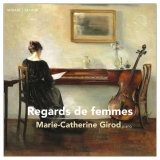Die französische Pianistin Marie-Catherine Girod spielt 19 meist kurze Stücke von nicht weniger als 17 Komponistinnen des 19. und 20. Jahrhunderts. Einige davon sind heute schon einigermaßen bekannt, andere nicht. Ob ihnen mit diesen nicht immer wirklich bedeutsamen Miniaturen zur Bekanntheit verholfen werden kann, ist fraglich. Sicher, die beiden Provence-Stücke von Jeanne Barbillon (1895-1992) lassen aufhorchen, und auch Cécile Chaminades virtuose Toccata sticht heraus aus einem Programm von meist nur gefälligen und charmanten Werken, die Marie-Catherine Girod einfühlsam und spielt und fein nuanciert. Und von Hélène der Montgeroult (1764-1836) hätte ich gerne mehr gehört als bloß einen in der Trackliste nicht einmal genau bezeichneten Satz (es ist ein Allegro agitato con fuoco) aus der der zweiten Sonate des Opus 5 (richtig hätte es in der Trackliste auch op. 5 Nr. 2 heißen müssen, und 8. Sonate wäre auch ein wichtiger Hinweis gewesen). Hinzu kommt dann noch, dass Nicolas Stavy in der bislang einzigen Aufnahme dieser Sonate diesen letzten Satz weitaus charakteristischer spielt als Girod. Das wirft umso mehr Fragen zum Sinn dieser Häppchen-CD auf.
French pianist Marie-Catherine Girod plays 19 mostly short pieces by no fewer than 17 women composers of the 19th and 20th centuries. Some of them are already reasonably well known today, others not. Whether these miniatures, which are not always really significant, can help them to become known is questionable. Certainly, the two Provence pieces by Jeanne Barbillon (1895-1992) attract attention, and Cécile Chaminade’s virtuoso Toccata also stands out from a program of mostly just pleasing and charming works, sensitively played and finely nuanced by Marie-Catherine Girod. And from Hélène der Montgeroult (1764-1836) I would have liked to hear more than just a movement which is not even correctly labeled in the track list (it is an Allegro agitato con fuoco) from the second sonata of Opus 5 (properly it should also have been called Op. 5 No. 2 in the track list, and ‘Sonata No. 8’ would have been an important information too). Then there is the fact that Nicolas Stavy, in the only recording of this sonata to date, plays this last movement far more characteristically than Girod. This raises all the more questions about the sense of this CD with a lot of bits.






















